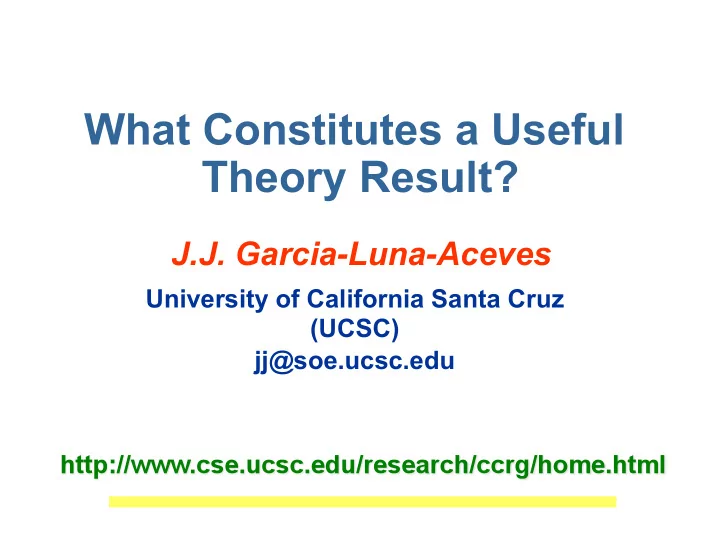

What Constitutes a Useful Theory Result? J.J. Garcia-Luna-Aceves University of California Santa Cruz (UCSC) jj@soe.ucsc.edu
What Is Network Theory? fundamental limits Lower-bound Upper-bound logic analytical models simulations APPLICATION collaborative applications… end-to-end transport protocols… TRANSPORT routing-structure opportunistic maintenance packet forwarding NETWORK interconnection transmission neighborhood LINK synchronization scheduling discovery PHYSICAL Antennas, radios Design & implement 2 Mechanisms, protocols and architectures for future networks 2
A Useful Theoretical Result It is defined based on the intent of the model! Must capture key aspect(s) of the logic, fundamental limit, or performance of algorithm, protocol or network architecture. Does not have to solve the precise implementation problem at hand. Can be translated into meaningful insight for design or implementation direction. 3 3
Some (Old) Examples Logic: Liveness and safety of ARQ protocols (selective repeat vs GBN vs stop-and-wait) and convergence of routing protocols. Nobody would design a window-based ARQ that just accepts pkts if there is buffer space at the receiver. Performance: Poisson approximations in modeling of channel access (ALOHA vs CSMA vs BTMA vs CSMA/CD). Comparison among these protocols was very useful even with magical secondary channel for ACKs and Poisson sources. Gallager’s necessary & sufficient conditions for optimum routing. Cannot be attained in practice but it is a useful upper bound. Limits: Order capacity of networks that embrace or avoid MAI 4 4
Recent Example 1: Taking a Hint from Capacity Results Wireless Ad Hoc Networks," Proc. IEEE Infocom 2008 , Phoenix, AZ, April 15--17, 2008. Z. Wang, H. Sadjadpour and J.J. Garcia-Luna-Aceves, ``A Unifying Perspective on The Capacity of Signaling overhead of routing protocols should be close to Θ (1) ⇒ Confine signaling to “regions of interest! Anycast & manycast ⇒ We MUST use in-network storage to bring or send content from/to nearest nodes 5 5 5
Recent Example 2: Schedule-based Access with Reservations 50 nodes placed randomly 50 HTTP flows, varying CBR flows Traffic to central access point Static routes, no coordination with MAC New New New New New scheme is self-synchronized distributed scheduling using reservations. Makes wireless mesh voice possible! Provides far better performance than 802.11e/n 6 6
Type of Theoretical Results Needed We should seek all three types! Logic, limits and performance Role of simulation models & analytical models? My wish list: PHY-layer impact (many parameters!) Cross-layer interaction Impact of amount of state needed/used at each node Impact of *many* cheap radios per node Embracing MAI (i.e., use concurrency in channel access and multihop dissemination) Consider all resources (bandwidth, storage & processing) 7 7
Thanks!
Recommend
More recommend